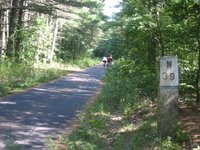To the Trucking Industry: We Thank Thee

Decades ago, freight largely moved by rail. I remember growing up in suburban Boston and watching long freight trains roll by our house on their way to Mechanicsville, NY and then further west. I'd count the rail cars, with my high-water mark being a 158-car freight train back in the early 1970s.
Today, of course, most freight moves over the road rather than over the rails. There are probably a whole host of reasons for this, but the railroad industry--at least in New England--is nothing like it was 'back then.' So, the 'silver lining' is that we have miles and miles of abandoned railroad lines that lend themselves perfectly to the development of recreational biking paths. Once the rails and wooden ties are removed and pavement put down, you give birth to a 'Rail Trail.'
The Nashua River Rail Trail is one such example. The Trail is completely paved along its 11-mile length, which runs from Nashua, New Hampshire down to Ayer, Massachusetts. When it was active many years ago, the rail line served as the Hollis Branch of the Boston and Maine railroad. It was part of a main rail link between Worcester and Nashua, and the very last freight train rolled over these rails in 1982.
Turning abandoned rail lines into 'Rail Trails' seems like a great thing to do and an easy thing to do. The former is true; the latter is not. Railroad right-of-ways necessarily weave through many towns. In the case of the Nashua River Rail Trail, that means Pepperell, Groton, and Dunstable (all in Massachusetts) in addition to Nashua and Ayer.
Five towns.
Politics being politics, you can easily grasp the complexities involved with getting five towns to agree on anything. In New England. Who will fund the paving? What happens if Pepperell agrees but Groton doesn't? How about maintenance? Parking? You quickly realize that everyone has to be on board for such an effort to get past the 'good idea' stage.
The trail opened in 2002, and kudos go to everyone who worked tirelessly to make that happen. Since then it has been hugely popular with bikers, roller-bladers, runners, and walkers. Quite simply, it's a great way to spend quality outdoor time, and you can do the entire 22-mile round-trip in about two hours...if you don't stop to admire the scenery and wildlife along the way. On nice weekends I'll often ride the trail twice, usually early in the morning before it starts getting busy. Since it spans an abandoned rail line, the Trail is flat and mostly straight. No hills of Kilimanjaro here, which might disappoint true mountain-biking enthusiasts. But let them go to Kilimanjaro; we'll take the Nashua River Rail Trail, thank you.
If you'd like to learn more about the Trail and its history, click the link on the right.


0 Comments:
Post a Comment
<< Home